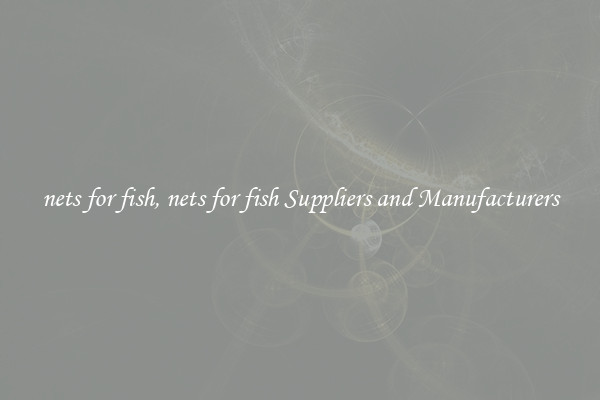nets for fish, nets for fish Suppliers and Manufacturers
Nets for Fish: A Crucial Tool for Fisherman

When it comes to fishing, nets play a vital role in the process of catching fish. These nets are specifically designed to trap and capture fish, allowing fishermen to efficiently haul in their catch. In this article, we will explore the importance of nets for fish, as well as the suppliers and manufacturers responsible for producing these essential tools.
Nets for fish come in various shapes and sizes, tailored to different fishing techniques and target species. The overarching purpose remains the same – to create a barrier that entraps fish, preventing them from escaping. Fishermen often use these nets in rivers, lakes, and oceans where fish migrate, providing an effective means of harvesting large quantities of fish.
One of the key aspects of nets for fish is their durability and strength. These nets are subjected to considerable strain as they are cast into the water and withstand the fight of the caught fish. To ensure longevity, suppliers and manufacturers meticulously craft them using high-quality materials, such as nylon, polyester, or even stainless steel. These robust materials withstand the corrosive effects of saltwater, along with the wear and tear inflicted by fish struggling to break free.
Notably, the design of the net is crucial to its effectiveness. Mesh size, spacing, and even the color of the netting all play significant roles in achieving successful catches. Different fishing methods require specific types of nets. For instance, seine nets are popular for catching fish close to the water's surface, while trawl nets are used to catch fish at all levels of the water column. Gill nets, on the other hand, are used to entangle fish by their gills.
Suppliers and manufacturers worldwide play a pivotal role in meeting the demand for nets for fish. These companies provide fishermen with a wide range of options to choose from, catering to varying fishing needs. With the advancement of technology, many manufacturers now implement innovative techniques, such as computer-aided design (CAD), ensuring the production of high-quality nets that maximize catch efficiency while minimizing environmental impact.
Additionally, transparency and sustainability have become paramount in the fishing industry. Hence, many suppliers and manufacturers employ ethical fishing practices, producing nets that minimize bycatch – the unintended capture of non-target species. By embracing responsible fishing methods, these companies contribute to the conservation and preservation of marine ecosystems.
In conclusion, nets for fish are invaluable tools for fishermen worldwide. Suppliers and manufacturers continuously strive to deliver durable and efficient nets that meet the diverse needs of the fishing community. Their commitment to sustainable fishing practices ensures the long-term viability of the industry while minimizing the impact on the environment. As the fishing industry continues to evolve, these nets will remain an essential component, helping fishermen harvest fish efficiently and responsibly.

View details

View details

View details

View details








